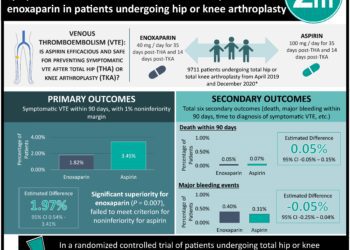Continuous or extended combined oral contraceptive regimens not linked to higher venous thromboembolism risk
1. In this retrospective cohort study, continuous (84/7) or extended (365/0) cycle regimens of combined oral contraceptives were not linked with meaningfully higher rates of venous thromboembolism (VTE) when compared with traditional cyclic (21/7) regimens.
2. This study excluded women with elevated baseline risk of venous thromboembolism (VTE).
Evidence Rating Level: 2 (Good)
Study Rundown: Approximately 17% of reproductive age women in the United States use combined oral contraceptives (COC), making them one of the widely prescribed medications in the country. Both estrogen-only as well as combined estrogen-progestin oral contraceptives have been shown to increase venous thromboembolism (VTE) risk, however more so with the latter, and so safety studies to date have focused primarily on VTE risk depending on type of progestin. In this large retrospective study, after adjusting for covariates and keeping the progestin type constant, extended and continuous COC regimens had a very small increase in rates of VTE. However, the low absolute risk difference (approximately 3000 person-years of treatment for 1 more case of VTE) and the significant baseline differences in cohorts suggested this difference was not clinically significant, and should not influence choice of regimen in this population.
While the large sample size (733,007 participants) supports this study’s conclusion, there are several significant limitations. Firstly, this study excluded the patients at highest risk of VTE, which are likely the patients where clinicians are most concerned with limiting even incremental risk. Secondly, the extended and continuous COC cohort was older and more medically complex. Thirdly, VTE results were not confirmed with chart review, which may have led to over- or under-estimation of treatment effect. Finally, despite the 8 year study period, the mean person-years at risk was only 0.7, which only allowed for a short period of exposure. Although a randomized control trial would likely not be feasible for this question, further study addressing these potential sources of bias would be helpful.
Click to read the study in JAMA Internal Medicine
Relevant Reading: Risk of venous thromboembolism in women taking the combined oral contraceptive: A systematic review and meta-analysis
In-Depth [retrospective cohort]: This was a retrospective cohort study drawing from the Sentinel Distributed Database, which includes data on 223,000,000 commercially insured patients in the United States. Notable, it was overseen by the United States Food and Drug Administration, and therefore it did not require clearance by an institutional review board. It included 733,007 incident users of combined oral contraceptives recruited between May 2007 and September 2015. 522,116 users (71%) initiated traditional 24/7 regimens, while 210,691 (29%) initiated extended (84/7) or continuous (365/0) regimens. Propensity matching was performed using age, calendar year, combined comorbidity score, health service utilization, medication utilization, use of any other hormonal treatment, gynecologic conditions, hypercoagulable states, coagulation defects, cardiovascular and metabolic conditions, venous catheterization, renal conditions, inflammatory conditions, obesity/overweight status, tobacco use, immobility, and surgery. This produced 203, 402 matched pairs. The primary outcome was first inpatient diagnosis of venous thromboembolism (VTE), although a sensitivity analysis was performed which broadened the definition to also include outpatient diagnosis of VTE followed by outpatient dispensing of anticoagulant within 4 weeks. Patients were followed until earliest occurrence admission to hospital for VTE, health plan disenrollment, cessation combined oral contraceptive (COC), initiation of any other hormonal product, death, pregnancy or live birth delivery, or the end of study period. Notably, these criteria allowed for a mean person-years at risk of only 0.7.
Among propensity matched pairs, incidence rate of VTE was 1.44 per 1000 person-years (95% CI 1.24-1.64) in extended/continuous COC users compared with 1.09 (95% CI 0.92-1.27) in traditional COC users. This resulted in an adjusted hazards ratio of 1.32 (95% CI 1.07 – 1.64). The absolute incidence rate difference was 0.35 per 1000 person-years. Subgroup analyses showed slightly higher adjusted hazard ratios (aHR) in users of 20 ug ethinyl estradiol (aHR 1.60, 95% CI 0.94-2.71) and users age 18-24 (aHR 1.66, 95% CI 0.95-2.90). Hazard ratios were similar when comparing only extended vs traditional regimens (n = 195, 637, aHR1.34, 95% CI 1.08-1.66) as well as only continuous vs traditional regimens (n = 11, 504, aHR 1.45, 95% CI 0.70-2.99). The broader VTE definition used in sensitivity analysis did not significantly change the aHR.
Image: PD
©2018 2 Minute Medicine, Inc. All rights reserved. No works may be reproduced without expressed written consent from 2 Minute Medicine, Inc. Inquire about licensing here. No article should be construed as medical advice and is not intended as such by the authors or by 2 Minute Medicine, Inc.







